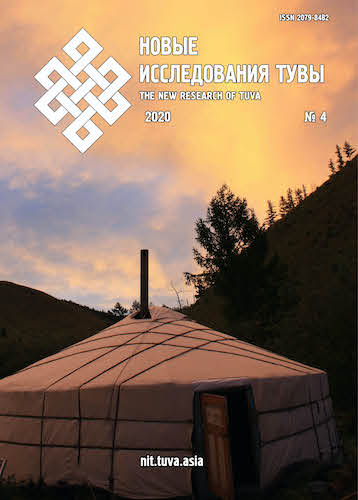Russian Buddhism and social media: Tuvan Buddhist online-communities on Vkontakte
DOI:
https://doi.org/10.25178/nit.2020.4.9Keywords:
Tuvan Buddhism; Tuvans; Tuva; religious community; Internet; Buddhism; online communityAbstract
The evolution of social media in recent years has demonstrated a new dimension of the correlation between tradition and innovation in religious life. Social media have become a special transformative space for Buddhist communities, a space which does not limit itself to using new information technologies. It also challenges these communities to preserve tradition and adapt to changes, get involved into global culture, and protect ethnic values.
The article examines the usage of media by Buddhist communities, taking Tuvan online communities on the social network VKontakte as our case study. We will specifically focus on the largest online Tuvan Buddhist VK community "Saryg Shazhyn Tyvada" (36000 users), which shows a steady growth in users. It is also among the largest Buddhism-related communities on this social network. With specially developed software, an automated data collection was carried out, which made possible to build a social graph. The analysis of the graph made use of mathematical modeling, namely, cluster analysis and calculation of its topological properties, assortativeness coefficient, degree distribution of nodes and betweenness degree.
Tuvan Buddhist online communities have pronounced ethno-religious peculiarities, an orientation towards reproducing ethnic tradition, the use of the Tuvan language, and a relatively high density of social communication. It can be assumed that for many users, participation in such online groups is one of the mechanisms for broadcasting ethnicity and adherence to traditions.
References
Aktamov, I. G., Badmatsyrenov, T. B. and Tsyrempilov, N. V. (2015) Rossiiskii buddizm v internet-izmerenii [Buddhism in Russia in the Internet dimension]. Vlast', no. 7, pp. 125–130. (In Russ.).
Aktamov, I. G., Badmatsyrenov, T. B., Khandarov, F. V. (2018) Osobennosti razvitiia virtual'nykh buddiiskikh soobshchestv Runeta [The peculiarities of the virtual Buddhist communities development in the Runet]. Vlast', no. 2, pp. 100–105. (In Russ.).
Badmatsyrenov, T. B., Skvortsov, M. V., Khandarov, F. V. (2018a) Buddiiskie tsifrovye praktiki transtsendentnosti: VK-soobshchestvo «Khambo Lama Dashi-Dorzho Itigelov» [Buddhist digital practices of transcendence: VK community “Hambo Lama Dashi-Dorzho Itigilov”]. Monitoring of Public Opinion: Economic and Social Changes, no. 2 (144), pp. 338–361. (In Russ.). DOI: https://www.doi.org/10.14515/monitoring.2018.2.18
Badmatsyrenov, T. B., Skvortsov, M. V., Khandarov, F. V. (2018b) Topologicheskie kharakteristiki buddiiskogo soobshchestva v sotsial'noi seti «VKontakte» [Topological characteristics of the Buddhist Community in the VKontakte social network]. Sotsiologicheskie issledovaniia, no. 8, pp. 74–82. (In Russ.). DOI: https://www.doi.org/10.31857/S013216250000756-4
Bazarov, B. V. (2014) Buddizm i vyzovy XXI veka [Buddhism and the challenges of the Third millenium]. Vestnik Buriatskogo nauchnogo tsentra Sibirskogo otdeleniia Rossiiskoi akademii nauk, no. 3 (15), pp. 12–16. (In Russ.).
Batura, T. V. (2012) Metody analiza komp'iuternykh sotsial'nykh setei [Methods of social networks analysis]. Vestnik Novosibirskogo gosudarstvennogo universiteta. Seriia: Informatsionnye tekhnologii, vol. 10, issue 4, pp. 13–28. (In Russ.).
Istoriia buddizma v SSSR i Rossiiskoi Federatsii v 1985–1999 gg. [The history of Buddhism in the USSR and the Russian Federation in 1985–1990] (2011) / ed. by. N. G. Ochirova. Elista, Ministerstvo obrazovaniia, kul'tury i nauki Respubliki Kalmykiia. 392 p. (In Russ.).
Lamazhaa, Ch. K. (2010) Klanovost' v politike regionov Rossii. Tuvinskie praviteli [The clan politics of Russia's regions. The Leaders Of Tuva]. St. Petersburg, Aleteiia. 208 p. (In Russ.).
Mongush, M. V. (2001) Istoriya buddizma v Tuve (vtoraya polovina VI — konets XX v.) [The History of Buddhism in Tuva (latter half of the 6th — late 20th cc.)]. Novosibirsk, Nauka. 200 p. (In Russ.).
Tarbastaeva, I. S. (2018) Buddiiskie tsennosti kak vozmozhnaia ekonomicheskaia determinanta razvitiia tuvinskogo obshchestva [Buddhist values as a potential economic determinant in the development of Tuvan society]. New Research of Tuva, no. 2, pp. 95–111. (In Russ.). DOI: https://www.doi.org/10.25178/nit.2018.2.5
Tenzin, Ch. M.-Kh. (2018) Buddizm v dukhovnoi zhizni tuvinskogo obshchestva [Buddhism in the spiritual life of Tuvan society]. BSU bulletin. Philosophy, no. 3, vol. 1, pp. 87–93. (In Russ.). DOI: https://www.doi.org/10.18101/1994-0866-2018-1-3-87-93
Ulanov, M. S. (2008) O prichinakh rasprostraneniia buddizma na Zapade v epokhu globalizatsii [Causes of Buddhism’s spread in the West in the epoch of globalization]. Vestnik Volgogradskogo gosudarstvennogo universiteta, Issue 7: Filosofiia. Sotsiologiia i sotsial'nye tekhnologii, no. 2 (8), pp. 68–72. (In Russ.).
Khomushku, O. M. (1998) Religiia v istorii kul'tury tuvintsev [Religion in the history of Tuvan culture]. Moscow, Institut etnologii i antropologii RAN. 177 p. (In Russ.).
Campbell, H. (2016) Surveying theoretical approaches within digital religion studies. New Media and Society, vol. 19, issue 1, pp. 1–10. DOI: https://doi.org/10.1177/1461444816649912
Campbell, H. (2010) When Religion meets New Media. New York, Routledge. 232 p.
Campbell, H. (2013) (ed.) Digital Religion: Understanding Religious Practice in New Media Worlds. London, Routledge. 288 p.
Campbell, H. and Evolvi, G. (2020) Contextualizing current digital religion research on emerging technologies. Human Behavior and Emerging Technologies, vol. 2, issue 1, pp. 5–17. DOI: https://doi.org/10.1002/hbe2.149
Connelly, L. (2015) Toward a Typology and Mapping of the Buddhist Cyberspace. In: Buddhism, the Internet, and Digital Media: The Pixel in the Lotus / G. P. Grieve, D. Veidlinger (eds.). New York, Routledge. 240 p. P. 58–78.
Grieve, G. P. and Veidlinger, D. (2016) Buddhist Media Technologies. In: The Oxford Handbook of Contemporary Buddhism / M. Jerryson (ed.) New York, Oxford University Press. 760 p. P. 469–483.
Helland, C. (2005) Online religion as lived religion methodological issues in the study of religious participation on the Internet. Online — Heidelberg Journal of Religions on the Internet, vol. 01.1 Special Issue on Theory and Methodology, pp. 1–16 [online] Available at: http://archiv.ub.uni-heidelberg.de/volltextserver/5823/1/Helland3a.pdf (access date: 12.09.2020).
Newman, M. E. J. (2003) Mixing patterns in networks. Physical Review E, vol. 67, no 2. DOI: https://doi.org/10.1103/PhysRevE.67.026126
Newman, M. E. J., Barabasi, A. and Watts, D. J. (2006) The Structure and Dynamics of Networks: (Princeton Studies in Complexity). Princeton, USA, Princeton University Press. 592 p.
Ostroumova-Prokhorenkova, L. and Krot, A. (2016) Assortativity in Generalized Preferential Attachment Models. In: Algorithms and Models for the Web Graph. Proceedings of the 13th International Workshop, WAW 2016, Montreal, QC, Canada, December 14–15, 2016 / A. Bonato, G. Fan Chung, P. Pralat (eds.). Cham, Springer International Publishing. Pp. 9–21. DOI: https://www.doi.org/10.1007/978-3-319-49787-7
Prebish, Ch. S. (1979) American Buddhism. North Scituate, Duxbury Press. 220 p.
Prebish, Ch. S. (2004) The Cybersangha: Buddhism on the Internet. In: Religion online: Finding faith on the Internet / L. L. Dawson, D. E. Cowan (eds.). London, Routledge. 288 p. Pp. 135–151.
Ray, G. (1994) A Resource Roundup for the Cybersangha. Tricycle: The Buddhist Review, no. 3(4), pp. 60-63.
Religion and cyberspace (2005) / Hojsgaard, M., Warburg, M. (eds.). New York, Routledge. 224 p.
Rheingold, H. (1993) The Virtual Community. New York, Harper Perennial. 325 p.
Schaeffer, S. E. (2007) Graph clustering. Computer science review, vol. 1, no. 1, pp. 27–64.
Schlutter, M. (2014) Buddhism in the Digital World. In: The Wiley Blackwell Companion to East and Inner Asian Buddhism / M. Poceski (ed.) Chichester, UK: John Wiley. 535 p. Pp. 505–522.
Published
How to Cite
Бадмацыренов Т. Б., Хандаров Ф. В., Бадараев Д. Д. Российский буддизм и социальные медиа: тувинские буддийские онлайн-сообщества ВКонтакте // Новые исследования Тувы. 2020, № 4. С. 120-134. DOI: https://www.doi.org/10.25178/nit.2020.4.9
For citation:
Badmatsyrenov T. B., Khandarov F. V. and Badaraev D. D. Rossiiskii buddizm i sotsial'nye media: tuvinskie buddiiskie onlain-soobshchestva VKontakte [Russian Buddhism and social media: Tuvan Buddhist online-communities on Vkontakte]. New Research of Tuva, 2020, no. 4, pp. 120-134. (In Russ.). DOI: https://www.doi.org/10.25178/nit.2020.4.9
Issue
Section

This work is licensed under a Creative Commons Attribution-NonCommercial 4.0 International License.

Author(s) license holder(s) grant rights for their work to the journal (grantee of a license) under the simple non-exclusive open license in accordance with Art. 1286.1 «Open license for a research work, work of literature or fine arts», Civil Code of the Russian Federation.
New Research of Tuva publishes articles under the Creative Commons Attribution-NonCommercial license (CC BY-NC).
Since it is an open license, author(s) reserve the right to upload the article to their institutional repository, submit it to another journal (if it allows republications), or republish it on their own website (in full, or in part).
However, several conditions apply here:
a) The republished version must always contain the name(s) and affiliation(s) of the author(s), the original title and the hyperlink to the original version on the New Research of Tuva website;
b) It must be in open access, free of charge, and no category of readers must be in any way whatsoever advantaged over general readership.
c) should the contribution be submitted elsewhere by its author(s) without substantial modification (30% or more of original text unchanged), the body of the article should contain a disclaimer that the original version was published in New Research of Tuva (with a link to the respective page)
The CC-BY-NC is a non-revocable license which applies worldwide and lasts for the duration of the work’s copyright.











